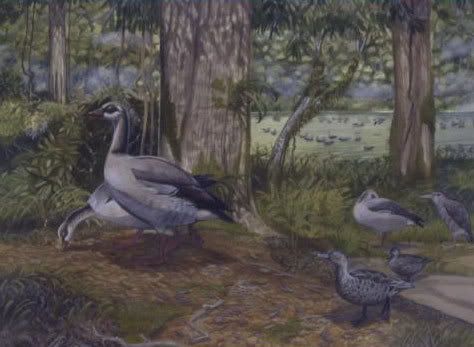|
|
Post by sebbe67 on May 16, 2005 17:00:03 GMT
Alopochen mauritianus
Mauritian Shelduck Alopochen mauritianus was endemic to Mauritius. Although the only specimens of the species are two carpometacarpii, it is known from numerous travelers' reports. In 1681, it was noted to be plentiful "in the woods or dry ponds", but it was presumably heavily hunted because it was described as "not large, but fat and good". By 1693, the species was rare and, by 1698, it was extinct.
|
|
|
|
Post by another specialist on Jun 6, 2005 4:45:13 GMT
Alopochen mauritianus
(Newton & Gadow) 1893
Pleistocene, subrecent of Mauritius, w Mascarene Islands, wc Indian Ocean
Primary materials: Type: Carpometacarpus
Bradley C. Livezey,
A phylogenetic classification of waterfowl (Aves: Anseriformes), including selected fossil species
Annals of Carnegie Museum 66 (1997): 457-496
|
|
|
|
Post by another specialist on Jun 8, 2005 7:24:29 GMT
Alopochen mauritianus Mauritian Shelduck Alopochen mauritianus was endemic to Mauritius. Although the only specimens of the species are two carpometacarpii, it is known from numerous travelers' reports. In 1681, it was noted to be plentiful "in the woods or dry ponds", but it was presumably heavily hunted because it was described as "not large, but fat and good". By 1693, the species was rare and, by 1698, it was extinct. source for info www.birdlife.net/datazone/search/species_search.html?action=SpcHTMDetails.asp&sid=30071&m=0 |
|
|
|
Post by Carlos on Feb 26, 2006 12:39:23 GMT
|
|
|
|
Post by another specialist on Jun 4, 2007 6:59:19 GMT
 Fig.2 (left). Mauritian Sheldgoose Alopochen mauritianus (Julian Hume) A large sheldgoose was reported by man to have been easy to catch and good to eat throughout the 17th century, but was not mentioned again after 1700. It was described as being like a European goose with red legs and black tips to the wings. It is known only from a few fragments collected in the Mare aux Songes in 1889. It appears to have inhabited dry woodland rather than a water environment. www.naturalis.nl/asp/page.asp?alias=naturalis.nl&view=naturalis.nl&id=i000256&frameurl=http%3A%2F%2Fwww.natura lis.nl%2Fget%3Fsite%3Dnaturalis.nl%26view%3Dnaturalis.nl%26id%3Di001200%26logId%3Dl000024%26execute%3Dshowsingleitem tinyurl.com/396oxo |
|
|
|
Post by another specialist on Jul 24, 2007 5:36:39 GMT
|
|
|
|
Post by another specialist on May 11, 2008 21:00:36 GMT
|
|
|
|
Post by surroundx on Aug 12, 2014 12:30:29 GMT
|
|
|
|
Post by Sebbe on Apr 28, 2015 20:28:37 GMT
Captive birds on Dutch Mauritius: bad-tempered parrots, warty pigeons and notes on other native animalsDuring the occupation of Mauritius by the Dutch in the seventeenth century, live dodos and other animals were transported to the east and west as curiosities and gifts by the Dutch East India Company. How these animals managed to survive these journeys, when human casualties on-board ship were so high, has remained a mystery. Here, we present for the first time a translation of the recently discovered report of Johannes Pretorius, who stayed on Mauritius from 1666 to 1669. Pretorius kept a number of now extinct birds in captivity, which was probably an experiment to ascertain their captive requirements prior to transportation. He also provides the first ecological details of some of the now-extinct birds and Mauritian giant tortoises, the impact of introduced animals, and highlights how little of the interior of Mauritius had actually been explored during this time. www.tandfonline.com/eprint/WnFVArrgx5iAKTXkS7cM/full#
|
|